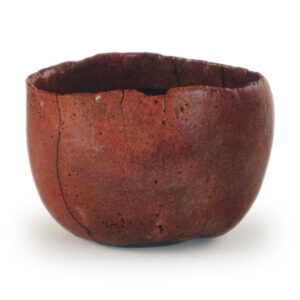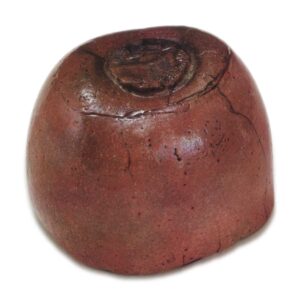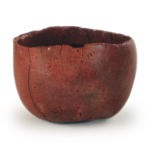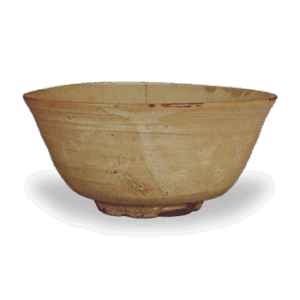

Height: 8.0-8.5cm
Diameter: 10.2-11.8cm
Base diameter: 4.0cm
The name “Otome” is clearly a reference to the shape of the tea bowl, which is reminiscent of the face of the Otome character from the comic book “Sanpei Niman Otafuku”.
Of the dozen or so famous tea bowls known to have been made by Koetsu, none are as interesting or as friendly in appearance as this Otome. In terms of elegance, there are the Fujiyama, Shigure and Shoji, while in terms of the richness of powerful design, there are the Amagumo, Yukiho and Kaga Koetsu, but in terms of the familiarity that makes it hard to part with it when it is in your hands, there is nothing that can surpass Otome, and it is likely that Sotan’s calligraphy on the side of the bowl was also written without hesitation when he picked up the bowl.
The foot ring was cut into a low, irregular circle, and while it was slightly concave at the edge, the rich roundness of the bowl continued down to the waist, and the free, yet not at all ostentatious workmanship was truly full of charm, and was a technique that transcended the common sense of tea bowl making, and was the work of a mind free of all obstacles.
However, looking at the inside, the bottom is raised quite a bit, and there are three thin vertical lines and one wide horizontal line around the waist, as well as a crack in the mountain, so it is thought that the dent in the foot was probably not caused when the bowl was being shaped, but rather that it naturally sunk in during the firing process. In a sense, it could be said that Koetsu’s free and easy spirit naturally brought out more interest than he was looking for.
Looking at the shape of the foot from above, the central foot is indented and the waist is plumply bulging in three directions, giving it the appearance of a three-peaked mountain, but looking at the rim of the tea bowl from above, it is also curved roundly in three directions, and here too there is something reminiscent of a smiling woman, and part of the rim is curved outwards.
As with all Koetsu’s tea bowls, there is no forced indentation in the middle of the bowl, and the inside is all wide and spacious. This tea bowl is no exception, and as I mentioned earlier, the bottom protrudes slightly inward during firing, so the center is slightly raised.
The tea bowl is made from a sticky red clay, and a thick layer of transparent glaze has been applied to it. It seems that it was fired at a fairly high temperature for a red Raku tea bowl of the time, and the glaze has melted beautifully to form a glassy surface, with slightly rough craquelure appearing all over. The glaze has a slightly purple tinge, which is a characteristic of Koetsu’s red Raku tea bowls and is not seen in Nongaku’s work. It was probably fired at a higher temperature than Nongaku’s Akaraku.
There are five marks on the foot ring, and there are five or six cracks of varying sizes around the rim.
On the lid of the paulownia box is the inscription “Otokose”, and the former owner, Roka Hirase, wrote on the paper covering the box “The person who wrote this box is unknown, but I hope it will be treasured for many years to come (signature in seal script)”. Judging from the handwriting, it is probably the work of Sen Sōtan, and there is no doubt about that. Come to think of it, Koetsu and Sotan were thought to have been very close friends, but it is strange that there are almost no famous Koetsu tea bowls that tell of their relationship.
The outer box is inscribed with the words “Koetsu red tea bowl, Otsu Gozen” in the handwriting of Saigyoan Shimomura Hinkuri.
The origin of the tea bowl is unknown, but if we imagine it in relation to the writing on the box, it may have been owned by Sōtan. Later, it came into the possession of the Hirase family of Osaka, and in 1903, when the family held a public auction, it was purchased by the 18-year-old Kanichiro Morikawa, and has since been a treasured item of the Jochūō family.








